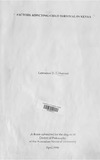| dc.description.abstract | This study investigated some factors which affected child survival in Kenya. The study had three main objectives. First, to establish the effects of selected socioeconomic factors and proximate variables on infant and child mortality in Kenya. Second, to establish some of the mechanisms through which socioeconomic factors influenced infant and child mortality. Third, to identify the determinants of infant and - child mortality in the two mortality regions: low- and high-mortality group of provinces; and to provide some insights into the differences in the levels of infant and child mortality between the two regions, using the case of Western and Central provinces. This thesis was based on data from the 1988/89 Kenya Demographic and Health Survey (KDHS) and the information obtained from the author's field work in Western and Central provinces. The analytical model developed by Mosley and Chen (1984) was adopted to guide the study. Logistic regression was used to analyse effects of the explanatory variables on infant and child mortality. The findings of the thesis showed that infant and child mortality varied according to socioeconomic status and proximate variables. Socioeconomic factors were shown to influence child survival through a complex web of pathways. Access to and use of health facilities, a toilet facility and piped drinking water were some of the mediating factors for most of the socioeconomic factors. The determinants of infant mortality were the province of residence, survival status of the preceding child, preceding birth interval, household economic status, birth order, paternal education and possession of livestock. With respect to child mortality, the following factors had significant net effects: the province of residence, preceding birth interval, year of birth of the child, succeeding birth interval, ever-use vii of modern contraception, household economic status and availability of a toilet facility. Much of the differences in the levels of infant and child mortality between the low- and high-mortality regions were due to the differences in the structure of relationships between mortality and explanatory variables in the two regions. In the low-mortality region, the determinants of infant mortality were the survival status of the preceding sibling, preceding birth interval, birth order, household economic status and place of residence. In contrast in the high-mortality region, the determinants of infant mortality were the preceding birth interval, survival status of the preceding sibling, possession of livestock, paternal education, maternal education, household economic status and maternal age at birth. In the low-mortality region, the determinants of child mortality were the preceding and succeeding birth intervals, maternal education and place of residence. In contrast in the high-mortality region, the determinants of child mortality were the preceding birth interval, year of birth of child, ever-use of modern contraception, succeeding birth interval and household economic status. The results suggest that the differences in the levels of infant and child mortality between Western and Central provinces were due to the differences in the levels of social and economic development, accessibility and utilisation of health facilities, and climatic/ ecological conditions in the two provinces. | en |

